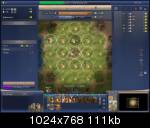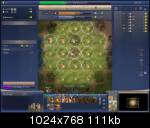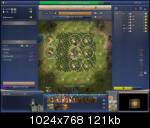Forewords
This article tries to explain how food and growth really works, and how granary and whipping affects it. Ive seen many explanations before, but all fail to cover some of the obscure questions ive always had, and some teories fail in contrast to what really happens. So, i decided to create a custom game and test it myself. Ive come to conclusions that really surprised myself, and maybe will surpise some more experienced players than me.
Questions I want to answer:
- How the “inner storage” of granary really works?
- How food from the granary is moved to food bar when growth happens?
- How (or if) whip affects population, food bar and the “inner storage” of granary?
This guide is not intented to:
- Optmize whipping, or discuss whipping strategies
- Optmize faster growth
For that, there are several articles already, some of them really awesome, specially on whipping.
Those not interested on the test methodoly can jump right to my conclusions, at the end of the post.
Methodology:
Here is the “Test City” i created for the testing:
All grasslands, +2 surplus food until culture expands, then +6 thanks to the corn. A small forest just to have some basic hammers. Im playing as Isabella (Spain), Spiritual+Expansive. This will accelerate the construction of the granary, and prevent the Anarchy when I change to Slavery. No techs beyond Bronze Working are needed for this testing, so ill just research what takes longer. All ill ever build will be the granary itself, and an Obelisk and Stonehenge for the whipping tests.
From now on, im only interested on current food stored on food bar, food stored on granary and food required to grow a pop. I will use this notation:
<Turn>: <Current Food> (<food on granary>) / <Food required to grow> (<current pop>)
The Testing:
So, here we goes. Starting with a +2 food surplus:
01: 00 (00) / 22 (1)
02: 02 (00) / 22 (1)
03: 04 (00) / 22 (1)
04: 06 (00) / 22 (1)
05: 08 (00) / 22 (1)
06: 10 (00) / 22 (1)
Now, city borders have expanded, i get access to the (convenintely farmed, irrigated and routed) corn. From now on ill have a +6 surplus food each turn:
07: 16 (00) / 22 (1)
City is ready to grow a pop, food would be 22/22, so no overflow food. Food bar will be reset, as we have no granary yet. Meanwhile, Brownze Working was researched, and i adopted Slavery. Thanks to Spiritual trait, no anarchy to interphere with the testing.
Moving on…
08: 00 (00) / 24 (2)
09: 06 (00) / 24 (2)
10: 12 (00) / 24 (2)
11: 18 (00) / 24 (2)
Ready to grow a new pop. Food would be 24/24, so, again, no overflow.
12: 06 (00) / 26 (3)
13: 12 (00) / 26 (3)
14: 18 (00) / 26 (3)
15: 24 (00) / 26 (3)
Ready for new pop. This time, 30/26, so we will have a 4 food overflow. Ive also switched production to Obelisk, to delay the granary a lil bit and test whipping with no granary involved.
16: 04 (00) / 28 (4)
Now, lets see how whipping affects the food bar when there is no granary.
16: 04 (00) / 26 (3)
Notice that nothing changes on the food bar. It remains 4/28. So, out first conclusin is: whipping does not affect food bar, even when no granary is present. The only effect is, now that pop is reduced to 3, food needed to next growth is 26. This is probably no news to most experienced players. Moving on…
17: 10 (00) / 26 (3)
18: 16 (00) / 26 (3)
Now the granary is ready, and it will start to store food surplus. Ill assume it will store all food surplus, not 50%, as later on this test it proved to be correct. So, each turn, the “inner storage” of the granary will also grow by 6 food. Please note that the granary will only start to store food after it is completed, not on the turn it was built. Granary was completed between turn 17 and 18, but its storage is still empty, and will only accumulate food now.
19: 22 (06) / 26 (3)
City is ready to grow. Food would be 28/26, so theres a 2F overflow. What about the inner storage of the granary? Would it be 12? How much food will be on food bar next turn? 0? 2? 9? 12? 13? 14? ? This is one of the trickiest turns of the whole testing. Any bets before seeing the next screenshot? 
Heres what really happened: food bar was reset, then overflow food was added to it, then all the food on granary´s inner storage (12, indeed) was added. Yes, all the food on granary. Not 50%. And remember, all food harvested was also stored on the granary. Not 50%. So we had 2 from overflow + 12 from granary = 14. Moving on…
20: 14 (00) / 28 (4)
21: 20 (06) / 28 (4)
22: 26 (12) / 28 (4)
Ready to grow. 32/28, so 4 overflow. Granary would have 18. So next turn food bar will have 18+4 = 22, right? Not exactly. Another interesting conclusion: granary storage is limited to half food needed to go up the current level. Granary will only add 14 food. So food bar will have 4 (form city overflow) + 14 (from granary) = 18. Last but not least, the food added to the city is not removed from the granary, so granary will still have 14 food after growth. So the actual food stored on granary on turns 20, 21 and 22 would be respectively 12 (food remains after growth), 14 (cap), 14 (cap). Due to this, the food that remains on granary basically becomes irrelevant from now on. If there is no starvation, it will always have half the food needed to grow.
All credit for most of the info on the above paragraph goes to Krikkitone. The limit of transfered food can be discovered by testing, but the info on the hard cap on granary storage and the fact that food is not subtracted would not be possible without his kind input.
23: 18 (14) / 30 (5)
Lets grow a few pop to check if this theory is correct
24: 24 (15) / 30 (5)
Ready to grow. Food will be 30 (15) / 30 = 0 overflow, +15 from granary
25: 15 (15) / 32 (6)
26: 21 (16) / 32 (6)
27: 27 (16) / 32 (6)
Ready to grow. Food will be 33 (19) / 32 = +1 overflow, +16 from granary
28: 17 (16) / 34 (7)
29: 23 (17) / 34 (7)
30: 29 (17) / 34 (7)
Ready to grow. Food will be 35 (21) / 34 = +1 overflow, +17 from granary
31: 18 (17) / 36 (8)
32: 24 (18) / 36 (8)
33: 30 (18) / 36 (8)
Ready to grow. Food will be 36 (22) / 36 = +0 overflow, +18 from granary. At this point, I think its safe to assume that the conclusions about granary and its inner storage are correct. Now, lets try to investigate a bit more the relation between whipping and food.
34: 18 (18) / 38 (9)
35: 24 (19) / 38 (9)
36: 30 (19) / 38 (9)
37: 36 (19) / 38 (9)
Ready to grow. Food will be 41 (28) / 38 = +3 overflow, +19 from granary
38: 23 (19) / 40 (10)
39: 29 (20) / 40 (10)
40: 35 (20) / 40 (10)
Ready to grow. Food will be 41 (27) / 40 = +1 overflow, +20 from granary
41: 21 (20) / 42 (11)
Now we have enough pop for our second whipping test, this time with granary present. The game says it will cost 5 pop: 
41: 21 (20) / 32 (06)
So, as expected, whipping did not change the current food. It is still 21. The only thing that changed was the required food, that dropped from 42 (11 pop) to 32 (pop 6). Again, this is no news to the experienced player, but i hope it helps the begginer player that are always confused about whipping and its effecs on growth.
But the testing is not done yet. One question remain: whipping didnt affect the food on the bat (city food), but did it affect the food on granary´s inner storage?. We hope not, but since we came this far, why not test it for sure? Its easy: lets grow a few pop and see if the overflow matches our expected value.
42: 27 (16) / 32 (06)
Ready to grow. Food will be 33 (19) / 32 = +1 overflow, +16 from granary. And the result is:
43: 17 (16) / 34 (07)
So, as expected, the granary food wasnt reset, not even halved, by the whipping. We can now safely say that whipping had no effect on the grannary, nor was affected by its presence.
As an exercice, lets find out what would happen if current food is large enough to make a city grow 2 pop in 1 turn. How would it be possible? If city size is, say, 12, and food is almost reaching next level (43/44), and we have a big surplus (10+), a full granary (22), and whip very hard (6 pop), then its possible to have more overflow (35) than the required to for the entire next level (34, pop 7). Will the game allow us to go from 6 pop to 8 pop in 1 turn if we have enough food overflow?
Here is the test:
X: 43 (22) / 44 (12)
Before whipping: 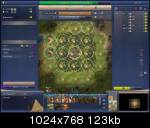 After whipping:
After whipping: 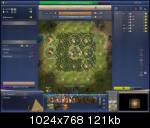
X: 43 (16) / 32 (06)
That will yeld to 11 overflow + 8 surplus + 16 from granary = 35, enough to completely bypass pop 7 (34 food required) and skip directly to pop 8. Lets see:
X+1: 35 (16) / 34 (07)
Too bad, there’s no free lunch  . Even with enough food avaliable, game requires at least 1 turn per pop.
. Even with enough food avaliable, game requires at least 1 turn per pop.
Note: some of you may have noticed that i had “only” 8 surplus food, even with rice and wheat, both farmed and irrigated. But i should have 9. Anyone has a clue where the “missing food” is? I have NO ideia. Comments welcome 
Conclusions:
- Each turn, the Granary stores in its “inner storage” the same amount of food that was havested by the city as surplus, up to half the food needed to grow up a population
Example: if you have a +2 food surplus in a city in a city size 6, each turn the granary will store 2 additional food up to a maximum of 16. - When a city grows a population, all the food stored on the granary is added to the city’s food bar. That food, however, is not subtracted from the granary.
Example: if you have 15 food stoted on a granary, and the city grows from 5 to 6 population, 15 food will be added to city, and granary will stay with 15 food. - Whipping population (by slavery) does not change the city’s food bar, nor the granary’s inner storage.
- Whipping effect is not affected by the presence of a granary. The good thing about having a granary when using whip is because city grows faster that way, thus you recover faster to original population. But Granary and whip have completely independent mechanics, one does not affect or is affected by the other.
- You cannot grow 2 population in a single turn, no matter how much surplus (or overflow) food you have.
Next steps:
- Find out how starvation relates to all of this, specially if the granary’s inner storage has any role on this. If anyone already knows, please tell me

- Check if whipping has any relation to starvation. Is there any penalty for whipping while at 0 food? Is it efficient to whip when starving, as youre going to lose pop anyway?
Afterwords:
I hope this article helped some to understand the obscure points about how the granary really works, and the relation between food, granary, whipping.
Most of whats here is no big news for experienced players, but i would really aprreciate any kind of comment, suggestion, corrections. Feel free to point mistakes i may have done. Anything that helps to improve this article is very welcome. Last but not least, thanks Krikkitone for in-depth info that led to many corrections.
Here are the savegames if you want to do this (any ony related) test for yourself. Ill supply 2: the initial savegame at 4000BC, and after i build those luxury and health resources to raise pop cap.
| RodrigoSilva BC-4000-GranaryTest-Start.Civ4SavedGame (12.1 KB, 10 views) | |
| RodrigoSilva BC-2800-GranaryTest-MoreResources.Civ4SavedGame (13.7 KB, 9 views) |



















